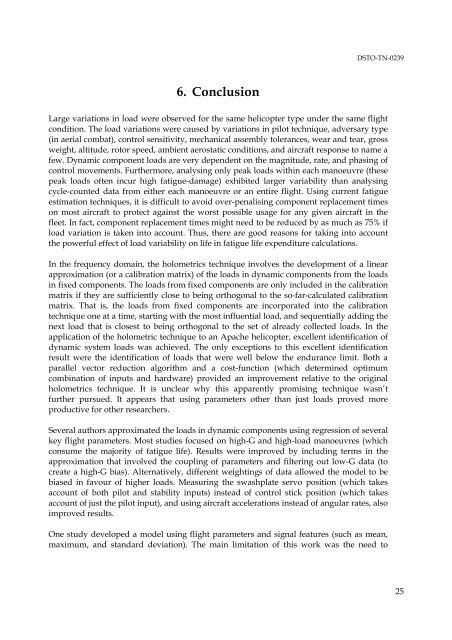Estimation of Structural Component Loads in Helicopters: A Review ...
Estimation of Structural Component Loads in Helicopters: A Review ...
Estimation of Structural Component Loads in Helicopters: A Review ...
Create successful ePaper yourself
Turn your PDF publications into a flip-book with our unique Google optimized e-Paper software.
DSTO-TN-02396. ConclusionLarge variations <strong>in</strong> load were observed for the same helicopter type under the same flightcondition. The load variations were caused by variations <strong>in</strong> pilot technique, adversary type(<strong>in</strong> aerial combat), control sensitivity, mechanical assembly tolerances, wear and tear, grossweight, altitude, rotor speed, ambient aerostatic conditions, and aircraft response to name afew. Dynamic component loads are very dependent on the magnitude, rate, and phas<strong>in</strong>g <strong>of</strong>control movements. Furthermore, analys<strong>in</strong>g only peak loads with<strong>in</strong> each manoeuvre (thesepeak loads <strong>of</strong>ten <strong>in</strong>cur high fatigue-damage) exhibited larger variability than analys<strong>in</strong>gcycle-counted data from either each manoeuvre or an entire flight. Us<strong>in</strong>g current fatigueestimation techniques, it is difficult to avoid over-penalis<strong>in</strong>g component replacement timeson most aircraft to protect aga<strong>in</strong>st the worst possible usage for any given aircraft <strong>in</strong> thefleet. In fact, component replacement times might need to be reduced by as much as 75% ifload variation is taken <strong>in</strong>to account. Thus, there are good reasons for tak<strong>in</strong>g <strong>in</strong>to accountthe powerful effect <strong>of</strong> load variability on life <strong>in</strong> fatigue life expenditure calculations.In the frequency doma<strong>in</strong>, the holometrics technique <strong>in</strong>volves the development <strong>of</strong> a l<strong>in</strong>earapproximation (or a calibration matrix) <strong>of</strong> the loads <strong>in</strong> dynamic components from the loads<strong>in</strong> fixed components. The loads from fixed components are only <strong>in</strong>cluded <strong>in</strong> the calibrationmatrix if they are sufficiently close to be<strong>in</strong>g orthogonal to the so-far-calculated calibrationmatrix. That is, the loads from fixed components are <strong>in</strong>corporated <strong>in</strong>to the calibrationtechnique one at a time, start<strong>in</strong>g with the most <strong>in</strong>fluential load, and sequentially add<strong>in</strong>g thenext load that is closest to be<strong>in</strong>g orthogonal to the set <strong>of</strong> already collected loads. In theapplication <strong>of</strong> the holometric technique to an Apache helicopter, excellent identification <strong>of</strong>dynamic system loads was achieved. The only exceptions to this excellent identificationresult were the identification <strong>of</strong> loads that were well below the endurance limit. Both aparallel vector reduction algorithm and a cost-function (which determ<strong>in</strong>ed optimumcomb<strong>in</strong>ation <strong>of</strong> <strong>in</strong>puts and hardware) provided an improvement relative to the orig<strong>in</strong>alholometrics technique. It is unclear why this apparently promis<strong>in</strong>g technique wasn’tfurther pursued. It appears that us<strong>in</strong>g parameters other than just loads proved moreproductive for other researchers.Several authors approximated the loads <strong>in</strong> dynamic components us<strong>in</strong>g regression <strong>of</strong> severalkey flight parameters. Most studies focused on high-G and high-load manoeuvres (whichconsume the majority <strong>of</strong> fatigue life). Results were improved by <strong>in</strong>clud<strong>in</strong>g terms <strong>in</strong> theapproximation that <strong>in</strong>volved the coupl<strong>in</strong>g <strong>of</strong> parameters and filter<strong>in</strong>g out low-G data (tocreate a high-G bias). Alternatively, different weight<strong>in</strong>gs <strong>of</strong> data allowed the model to bebiased <strong>in</strong> favour <strong>of</strong> higher loads. Measur<strong>in</strong>g the swashplate servo position (which takesaccount <strong>of</strong> both pilot and stability <strong>in</strong>puts) <strong>in</strong>stead <strong>of</strong> control stick position (which takesaccount <strong>of</strong> just the pilot <strong>in</strong>put), and us<strong>in</strong>g aircraft accelerations <strong>in</strong>stead <strong>of</strong> angular rates, alsoimproved results.One study developed a model us<strong>in</strong>g flight parameters and signal features (such as mean,maximum, and standard deviation). The ma<strong>in</strong> limitation <strong>of</strong> this work was the need to25
















